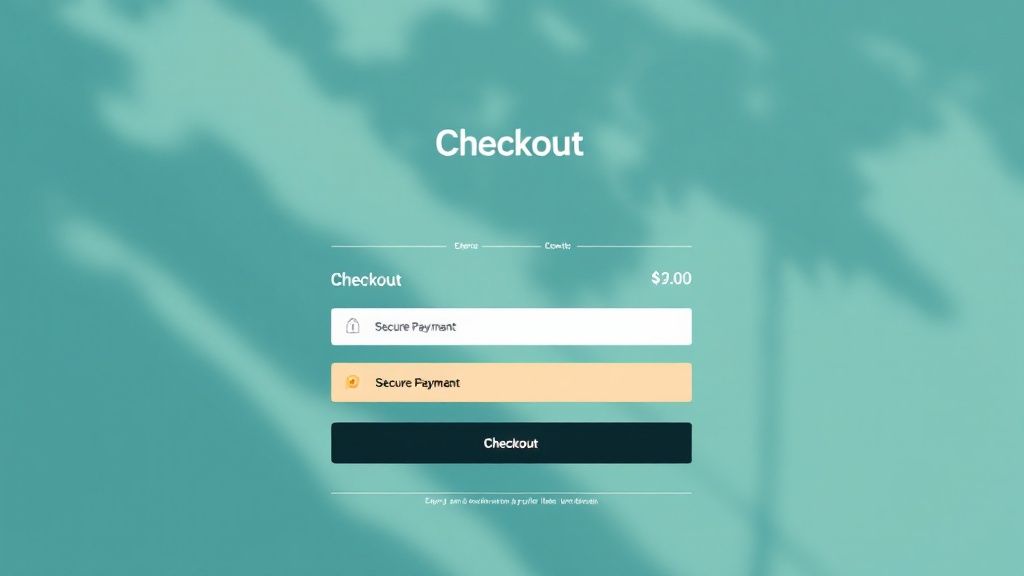How to Reduce Abandoned Carts Shopify: Top Strategies
April 26, 2025

Understanding Cart Abandonment: What's Really At Stake
Before diving into solutions for abandoned carts on your Shopify store, it's crucial to understand the financial impact. Think of abandoned carts like a leaky faucet: a small drip might seem insignificant, but over time, it leads to substantial water loss. Similarly, each abandoned cart represents potential revenue slipping away. Quantifying this loss reveals hidden opportunities for growth and emphasizes the importance of cart recovery efforts.
Calculating Your True Abandonment Rate
Many Shopify merchants rely solely on the basic abandonment rate provided in their analytics dashboard. However, a deeper understanding requires more than this surface-level metric. For a more accurate picture, you need to consider the abandoned cart value. This isn't just about the percentage of abandoned carts, but the actual dollar amount left behind. Calculating this value translates percentages into tangible losses, providing a powerful motivator to address the issue. To calculate your abandoned cart value, multiply your average order value by your abandonment rate. This represents the potential revenue you're missing out on each month.
Benchmarking Against Industry Standards
Understanding how your store's performance compares to others within the Shopify ecosystem and the broader e-commerce landscape provides valuable context. The average cart abandonment rate across e-commerce platforms hovers around 70-72%, with fluctuations by month and region.
For instance, Oberlo highlights rates ranging from 67.30% to 76.32% within a year. Baymard Institute estimates that 70.19% of online shoppers abandon carts globally, representing a staggering $260 billion in potentially recoverable revenue. Explore this topic further here.

This data emphasizes that cart abandonment is a widespread challenge, but also underscores the significant potential for improvement. Benchmarking allows you to assess whether your abandonment rate is a cause for immediate concern or requires strategic refinement.
Identifying Areas for Improvement
Once you have a clear picture of your abandonment rate and its associated value, you can begin to pinpoint areas for improvement. Consider factors like unexpected shipping costs, complicated checkout processes, and a lack of payment options. These are common culprits contributing to abandoned carts. Identifying these friction points in your customer journey is the first step towards implementing targeted solutions. By addressing these pain points, you can transform lost sales into recovered revenue, strengthening your bottom line and fostering customer loyalty.
Transforming Your Shopify Checkout Experience
The checkout process is the final hurdle for customers, standing between browsing and buying. It's also the most common point of cart abandonment. This isn't a minor issue; small changes to your Shopify store's checkout can significantly improve your conversion rate. Rethinking your checkout flow can drastically reduce abandoned carts and boost your bottom line.
Streamlining The Checkout Process For Higher Conversions
Successful Shopify merchants know a seamless checkout is crucial. They reduce friction by minimizing the number of form fields, making the process quick and easy. The fewer steps customers take, the more likely they are to complete a purchase. Consider using pre-filled forms, offering guest checkout, and enabling auto-fill functionality.
Adding progress indicators keeps customers engaged and informed about their progress. Like a roadmap for a traveler, a progress bar provides a clear path, encouraging customers to complete their purchase.
The Power of Guest Checkout and Optimized Apps
Offering a guest checkout option removes the obstacle of mandatory account creation. While creating accounts for future benefits is valuable, requiring it upfront can discourage spontaneous purchases. Strike a balance by highlighting account benefits while prominently displaying a guest checkout button.
Many Shopify apps promise checkout enhancements, but choose wisely. Some apps can inadvertently create new friction points. Prioritize apps that streamline processes, improve functionality, and seamlessly integrate with your current setup. For more helpful advice, check out our guide on troubleshooting Shopify checkout issues.
A/B Testing: Your Key To Continuous Improvement
A/B testing is essential for optimizing your checkout and understanding your audience. Experiment with checkout variations and analyze their performance. Test different button placements, form field layouts, or even the wording on your call-to-action buttons. This data-driven method will expose hidden friction points and reveal improvement opportunities.
Device-specific abandonment rates further highlight critical areas for improvement. Learn more about abandoned cart statistics. Mobile shoppers, accounting for over 76% of abandoned carts, often encounter cumbersome input fields and slow loading times. Even desktop users, with a 57.95% abandonment rate, contribute to significant revenue loss. Analyzing these metrics helps tailor optimizations for each device.
To help you further optimize your checkout process, we've created a handy checklist:
This checklist summarizes key elements to optimize within your Shopify checkout, outlining their implementation difficulty and potential impact on reducing cart abandonment:
| Checkout Optimization Checklist for Shopify Stores | A comprehensive checklist of elements to optimize in your Shopify checkout process with their impact on cart abandonment rates |
|---|---|
| Optimization Element | Implementation Difficulty |
| Streamlined Form Fields | Easy |
| Guest Checkout Option | Easy |
| Progress Indicator | Medium |
| Optimized Apps | Medium |
| Mobile-First Design | Medium |
| A/B Testing | Medium |
| Page Load Speed | Hard |
| Clear Call to Actions | Easy |
| Security Badges | Easy |
| Multiple Payment Options | Medium |
By utilizing this checklist, you can systematically address key areas in your checkout process and significantly reduce cart abandonment. Remember to prioritize elements based on their potential impact and implementation difficulty.

Building A Checkout Optimized For Your Customer
Your checkout process isn't a one-size-fits-all solution. For further improvement strategies, you might be interested in: How to master your checkout process. Optimizing your checkout involves continuously evaluating your store's specific needs and adapting to customer behaviors. By embracing data-driven decisions and focusing on continuous improvement, you can transform your checkout from a point of abandonment into a powerful conversion engine.
Crafting Cart Recovery Emails That People Actually Open
Email remains a powerful tool for recovering abandoned carts on Shopify. However, generic "we miss you" messages are no longer effective. Successful Shopify merchants craft targeted email sequences that achieve open rates far above the average 41.18% cited by research from Klaviyo and see recovery rates 2-3X higher than the industry average. This means focusing on timing, subject lines, and email content to maximize your recovery potential.
Timing Is Everything: When To Send Your Emails
The timing of your abandoned cart emails is crucial. The first email should be sent within one hour of abandonment, capitalizing on the customer's recent engagement. A customer abandoning a cart with high-value items might receive a follow-up sooner than someone browsing lower-priced goods. The type of product can also influence timing. For example, a customer considering a perishable item needs a faster follow-up than someone looking at a durable good.
Subject Line Psychology: Grabbing Their Attention
Your subject line is the first impression and the gateway to recovering a lost sale. A compelling subject line can significantly boost open rates. Effective subject lines often use personalization, mentioning the specific product left behind. They can also create a sense of urgency or exclusivity, enticing the customer to return. Consider subject lines like "Still thinking about that [product name]?" or "Don't miss out! Your [product name] is waiting."
Content That Converts: More Than Just a Reminder
Your email content should be more than a simple cart reminder; it needs to re-engage the customer and address potential reasons for abandonment. Highlighting product benefits, showcasing social proof like customer reviews, or offering a limited-time discount can incentivize the customer to complete their purchase. Checkout Links can be especially beneficial, allowing customized shoppable links that pre-fill the customer's cart and apply discounts automatically. Learn more in this article about best practices for abandoned cart emails.

Automating Your Workflow: Shopify Email, Klaviyo, and Omnisend
Setting up automated email workflows is essential for efficient cart recovery. Platforms like Shopify Email, Klaviyo, and Omnisend provide the tools to create sophisticated abandoned cart sequences triggered by specific customer actions. You could create a three-email sequence: a gentle reminder, then highlighting product benefits and social proof, and finally offering a small discount or free shipping. This automated approach ensures consistent follow-up, maximizing your recovery chances.
Capturing Shoppers Before They Leave: Exit-Intent Magic
The moment a shopper moves their cursor towards the "close" button presents a valuable opportunity. This crucial moment, right before they abandon their cart, is often underutilized by Shopify merchants. However, strategic exit-intent popups and on-site messaging can significantly reduce abandonment rates without disrupting the shopping experience. These targeted interventions can be the difference between a lost sale and a recovered customer.
The Psychology of Exit-Intent Offers
Exit-intent technology detects when a user is about to leave your site. This allows you to present a timely offer, capturing their attention before they disappear. The effectiveness of these popups lies in understanding the psychological triggers that make them compelling. Offering a discount, free shipping, or a limited-time promotion creates a sense of urgency and encourages immediate action. For example, a popup that reads, "Wait! Get 10% off your order today," can be highly persuasive.
Discount Strategies That Recover Sales
While discounts are effective, they need to be implemented strategically. Offering discounts too frequently can train customers to abandon carts intentionally, expecting a price reduction. Instead, consider offering discounts for first-time buyers, for orders above a certain value, or for specific product categories. This approach encourages larger purchases and avoids devaluing your products.
Recommended Shopify Apps and Configurations
Several Shopify apps specialize in exit-intent popups, such as Privy and OptiMonk. These apps offer customizable templates, advanced targeting options, and A/B testing capabilities. For instance, you can target popups based on cart value, product category, or even the number of visits. A higher cart value might warrant a larger discount or free expedited shipping, while a lower cart value could benefit from a smaller discount or free gift.

Prioritizing Sales Recovery vs. List Building
Exit-intent popups can also be used to grow your email list. Instead of offering a discount, you can incentivize email sign-ups with exclusive content, early access to sales, or entry into a giveaway. The choice between prioritizing immediate sale recovery and building your email list depends on your business goals. If your primary goal is to reduce cart abandonment, offering a discount is likely the better option. However, if building long-term relationships is a priority, then list building through exit-intent popups can be a valuable strategy. Remember to always respect privacy regulations and ensure your popups are compliant with data collection laws.
Eliminating Price Shock: The Transparency Advantage
Unexpected costs are the number one reason shoppers abandon their carts. A Baymard Institute study revealed that 48% of shoppers abandon their purchases due to extra costs like shipping, taxes, and other fees. Many Shopify merchants reveal these costs only at the final checkout stage. This can create price shock, resulting in lost sales. This section explores how transparency can significantly reduce abandoned carts on Shopify.
Communicating Shipping Costs Early
Being upfront about shipping costs early in the browsing experience can preemptively address customer concerns and build trust. This doesn't require displaying exact amounts for every product on every page. A simple banner announcing your shipping policy, such as "Free shipping on orders over $50," can make a big difference.
For instance, stores like Glowstore display shipping information directly on product pages. This allows customers to factor in shipping costs before adding items to their cart.
Free Shipping Thresholds: A Win-Win Strategy
Offering free shipping above a certain order value incentivizes customers to spend more. This can increase your average order value (AOV) while reducing abandoned carts. Free shipping has become a common practice in e-commerce, aligning with customer expectations. This benefits both the merchant and the customer.
Displaying Tax Estimates Before Checkout
Just like shipping costs, unexpected taxes can cause cart abandonment. Providing clear tax estimates before checkout eliminates a potential point of friction. Shopify allows for real-time tax calculations based on the customer's location. This allows for accurate estimates that prevent surprises at checkout.
Shopify Shipping Zones and Real-Time Calculators
Shopify provides tools for managing shipping costs. Shipping zones allow you to define different shipping rates based on geographic location. Real-time shipping calculators can be implemented on your product pages, offering instant cost estimates based on the customer's address.
Delivery Timeframe Communications: Managing Expectations
Delivery time significantly influences purchasing decisions. Clearly communicating estimated delivery timeframes manages customer expectations and reduces anxiety about delays. Integrating apps like Checkout Links with your email marketing platform can enhance this process. Shoppable links pre-fill carts and apply discounts, streamlining checkout for returning customers. These links can also communicate specific delivery information, reinforcing transparency and reducing abandonment rates.
Turning Shipping into a Competitive Advantage
By being proactive and transparent about shipping costs and delivery times, you transform shipping from a potential issue into a competitive advantage. This positive customer experience can set your store apart.
To understand how different shipping strategies impact your business, let’s take a closer look at the following table:
Impact of Different Shipping Strategies on Abandonment Rates: Comparison of different shipping approaches and their effect on cart abandonment and average order value
| Shipping Strategy | Average Impact on Abandonment Rate | Effect on AOV | Best For Store Types |
|---|---|---|---|
| Free Shipping | Significant Decrease | Potential Increase | High-volume, low-margin |
| Conditional Free Shipping (Threshold) | Moderate Decrease | Likely Increase | Most store types |
| Flat Rate Shipping | Minimal Impact | Neutral | Simple product lines |
| Real-Time Calculated Shipping | Variable | Neutral | Complex shipping needs |
This table shows how various shipping strategies influence abandonment rates and AOV. Choosing the right strategy for your store and products is crucial for optimizing conversions. Addressing shipping concerns builds customer trust, reduces abandoned carts, and drives sales.
Retargeting That Reconnects: Beyond Basic Reminders
Generic retargeting campaigns can lead to wasted ad spend and ad fatigue, where potential customers become numb to your ads. Instead of simply reminding shoppers about items left in their carts, a more strategic framework is needed. Re-engage customers with personalized messaging and attractive offers. This approach can significantly improve your return on investment (ROI).
Advanced Audience Segmentation: Targeting the Right Shoppers
One of the best ways to reduce abandoned carts on Shopify is through advanced audience segmentation. This means dividing your audience into smaller groups based on specific behaviors and characteristics. This allows you to create retargeting ads tailored to their individual needs. Instead of a blanket message, you can deliver highly relevant ads that connect with each segment.
-
Cart Value: Customers abandoning high-value carts need different messaging and incentives than those abandoning low-value ones. A high-value cart might justify a larger discount or free expedited shipping. A lower-value cart might respond better to a smaller discount or a free gift with purchase.
-
Product Category: Consider the products left behind. Someone abandoning electronics might be interested in an extended warranty. Someone abandoning beauty products might be swayed by a free sample. Tailoring your ads to the product category increases their impact.
-
Abandonment Time: How long ago did a customer abandon their cart? A recent abandonment may only need a gentle nudge. An older one may require more enticing offers or showcasing alternative products.
Crafting Compelling Ad Creative: Re-Engaging Lost Customers
Your ad creative is critical for retargeting success. Forget the generic "Complete your purchase" message. Develop compelling visuals and copy that address the reasons behind cart abandonment.
-
Highlight Product Benefits: Remind shoppers why they were interested in the first place. Showcase the product's unique features, benefits, and overall value.
-
Showcase Social Proof: Build trust and credibility. Incorporate customer testimonials, positive reviews, or user-generated content in your ads.
-
Offer Time-Sensitive Incentives: Encourage immediate action with limited-time discounts, free shipping, or other special promotions. This can be the push a shopper needs to complete their purchase.
For example, Checkout Links helps create customized shoppable links for your retargeting ads. These links pre-fill the customer's cart with abandoned items and can automatically apply discounts, simplifying the checkout process and increasing conversions. This direct approach minimizes friction and makes purchasing easier.
Budget Allocation and Performance Measurement: Maximizing ROI
Allocate your retargeting budget wisely, focusing on segments with the highest potential ROI. This could mean bidding more aggressively on high-value cart abandoners or concentrating on product categories with strong conversion rates.
Accurate performance measurement is crucial for maximizing ROI. Go beyond basic metrics and focus on incremental lift. This measures the additional conversions generated specifically by your retargeting efforts. This way, you're not giving retargeting credit for sales that would have happened anyway. Tools like Facebook's conversion lift studies can help you isolate the impact of your retargeting campaigns and truly assess their effectiveness. Frequency capping is also essential. This limits the number of times a user sees your ad within a specific timeframe, preventing ad fatigue and optimizing your ad spend. This keeps your ads effective without overwhelming potential customers.
Building Purchase Confidence: Trust Signals That Convert
For new Shopify stores, building customer trust is crucial. Customers often hesitate to buy not because they aren't interested in the products, but because they are uncertain about the store itself. Strategically placed trust signals can significantly reduce abandoned carts driven by these concerns. These signals reassure customers, bridging the gap between browsing and buying.
The Power of Reviews and Testimonials
Customer reviews and testimonials are powerful trust builders. They're like word-of-mouth marketing in the digital age, providing social proof that others have had positive experiences with your products. Strategically placing reviews on product pages, near the "Add to Cart" button, or even during checkout can significantly impact purchase decisions. For example, a carousel of positive reviews near the checkout button can reassure hesitant buyers.
Trust Badges and Security Indicators
Security concerns are a major reason for cart abandonment. Baymard Institute found that 25% of shoppers abandon carts due to security concerns. Displaying trust badges from reputable security providers and payment processors can alleviate these anxieties. These badges act as visual cues, assuring customers that their payment information is safe. Also, ensure your site has an SSL certificate, indicated by the padlock icon in the browser address bar. This signifies a secure connection, further building trust.
Guarantees That Reduce Perceived Risk
Offering strong guarantees, such as a money-back guarantee or a hassle-free return policy, can reduce perceived risk. These guarantees demonstrate confidence in your products and assure customers that they can purchase without worry. Clearly stating your guarantee policy on product pages and during checkout can encourage hesitant buyers to complete their purchase. A "30-Day Money-Back Guarantee," for example, can significantly reduce the risk of purchasing an unfamiliar product.
Accessible Customer Service
Easy access to customer service builds trust. Prominently displaying contact information, offering live chat support, and providing a comprehensive FAQ section can address customer questions and concerns promptly. This accessibility shows you're available to help, encouraging purchases. However, ensure these elements don't clutter the user experience or slow down site load speed, which can negatively impact customers.
Shopify Apps for Enhanced Trust
Several Shopify apps can help implement these trust-building elements. For instance, Yotpo specializes in collecting and displaying customer reviews. Other apps offer trust badges and security seals, while others focus on creating visually appealing guarantee banners. Checkout Links enhances customer service and trust by providing customized shoppable links. These links can pre-fill cart information, streamlining the checkout process and boosting conversions. This convenient and personalized experience enhances customer satisfaction and reinforces trust. Ready to turn abandoned carts into conversions? Checkout Links offers a comprehensive solution to enhance your email marketing and automate workflows, helping you recover lost sales and improve profits.
 Checkout Links
Checkout Links



